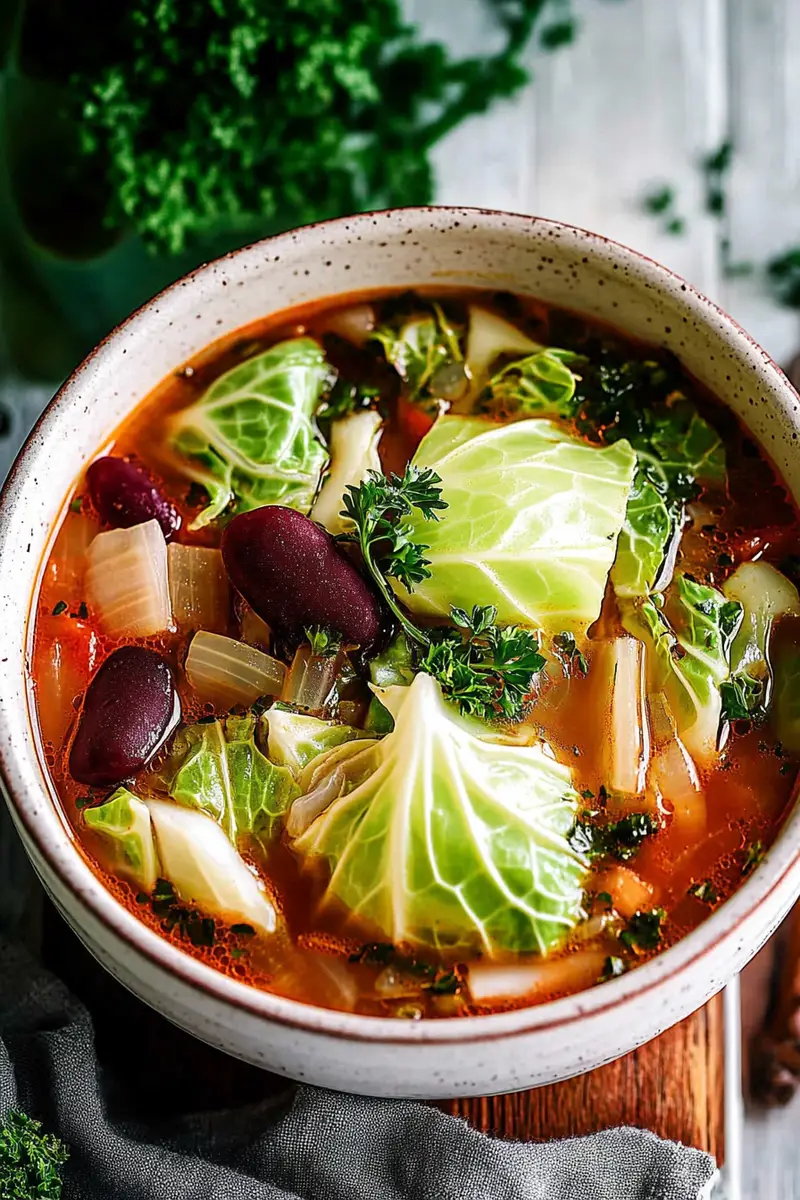Introduction and Quick Summary
Cabbage soup is not just a dish; it’s a warm hug in a bowl. Bursting with flavor and nutrients, this hearty soup has become a staple for those looking to enjoy delicious yet healthy meals. With its rich blend of vegetables and spices, cabbage soup offers comfort on chilly days while also supporting your wellness goals. Whether you’re trying to lose weight or simply want to eat better, this recipe is an excellent choice.
Making cabbage soup is straightforward and requires minimal ingredients. However, the results are exceptional—it’s filling, budget-friendly, and versatile. You can easily modify it by adding your favorite vegetables or proteins. Plus, it’s perfect for meal prep! You can batch cook it at the start of the week and enjoy it throughout. This recipe will guide you through making your very own pot of warm cabbage goodness.
In this article, we’ll explore the essential ingredients you’ll need to create this delightful dish. We’ll also provide step-by-step instructions on how to prepare cabbage soup so that even beginner cooks can follow along effortlessly. Finally, we’ll share tips on serving and storing your creation. Let’s dive into the world of cabbage soup!
Main Ingredients
Cabbage
Cabbage serves as the star of this dish. You will need one medium head of green or savoy cabbage—about 2 pounds when trimmed and chopped. Rich in vitamins K and C, cabbage offers numerous health benefits including improved digestion and reduced inflammation. For best results in your soup, ensure you chop the cabbage into bite-sized pieces to allow for even cooking and flavor absorption.
Carrots
Two medium carrots are required for added sweetness and color in your cabbage soup. Chopped into thin rounds or diced finely, carrots provide essential beta-carotene which converts into vitamin A in your body. This contributes to better vision, skin health, and immune function. The sweetness from the carrots balances out the earthy flavors of the cabbage beautifully.
Celery
You will need three stalks of celery to enhance the overall flavor profile of the dish. Celery adds a crunchy texture and subtle saltiness that complements other ingredients well. It is also low in calories but high in water content which makes it great for hydration. Dicing celery into small pieces ensures they cook evenly alongside the other vegetables.
Onion
For depth of flavor, include one large onion in your recipe. Diced finely or roughly chopped depending on preference, onions provide sweetness as they caramelize during cooking while also being rich in antioxidants and anti-inflammatory properties. Onions are fundamental in building layers of flavor that make your cabbage soup truly enjoyable.
Garlic
Garlic is essential for adding aroma and richness to your dish; use four minced cloves for optimal flavor enhancement. Known for its health benefits including boosting immunity and reducing blood pressure levels, garlic elevates not only taste but also nutritional value significantly when included in soups.
Vegetable Broth
Using six cups of vegetable broth as your base gives depth to your dish while keeping it vegetarian-friendly if desired! This broth brings all flavors together harmoniously without overpowering them; feel free to substitute with chicken broth if preferred! Opting for low-sodium versions allows you control over saltiness levels in your final product.
Tomatoes
You will require two cups of diced tomatoes (fresh or canned) which add acidity and brightness to balance out flavors effectively! Their juiciness helps create a rich liquid base ideal for soups while packing an extra punch from both vitamins C & K—perfectly rounding out this nourishing meal!
Spices
Seasoning is key! Use a combination of 1 teaspoon each of dried thyme and oregano along with salt & pepper according to taste preferences! These spices elevate all elements within the pot—do not skip them! Add more herbs if desired; fresh herbs can be used too!
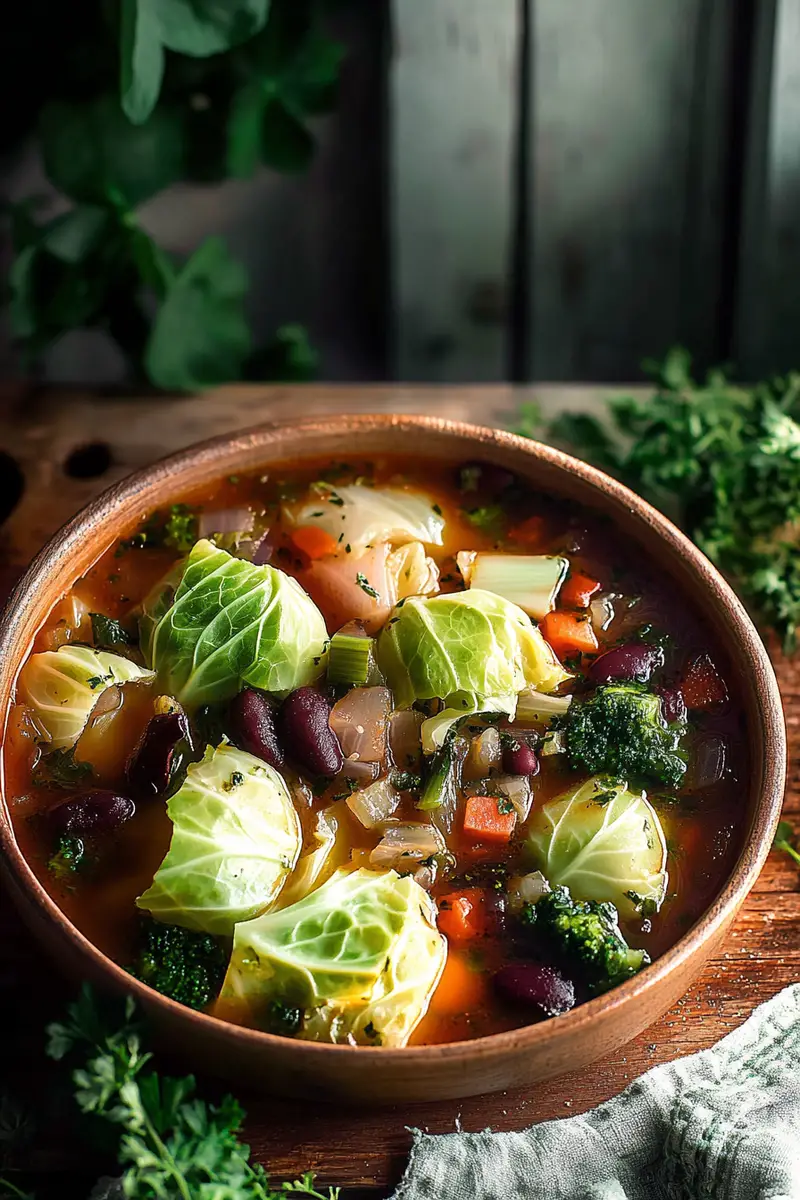
How to Prepare Cabbage Soup
Step 1: Prepare Your Ingredients
Start by washing all vegetables thoroughly under cool running water before chopping them as described earlier—this ensures cleanliness throughout preparation processes! Begin with dicing onions first since they take slightly longer than others; then move onto celery followed by carrots before finally chopping up that vibrant head of cabbage last so none turns brown prematurely! Lastly set aside those diced tomatoes ready for their turn next!
Step 2: Sauté Vegetables
In a large stockpot over medium heat drizzle about two tablespoons olive oil—allow heating until shimmering appears on surface before adding chopped onions directly into pot stirring occasionally until translucent (about 5 minutes). Next add minced garlic followed quickly by diced celery & carrot cooking another 3-4 minutes until softened appropriately—this forms aromatic base essential before moving forward toward next steps!
Step 3: Combine All Ingredients
Once sautéed veggies have softened adequately pour vegetable broth carefully over mixture ensuring everything gets submerged fully within liquid depths while stirring gently bringing together uniformity among veggies present inside pot! Follow up by incorporating chopped cabbage plus diced tomatoes allowing them time too mingle harmoniously among existing flavors already present inside pot—we want all elements combined well at this stage!
Step 4: Season And Simmer
After combining everything season generously with dried thyme oregano plus salt & pepper according personal preference levels adjusting accordingly after tasting initial simmered result(s). Bring broth back up towards boiling point then reduce heat down lower allowing gentle simmer action occur here—from start-to-finish let simmer away anywhere between 30-45 minutes until tenderized textures achieved throughout every component involved contributing richness found within final product produced!
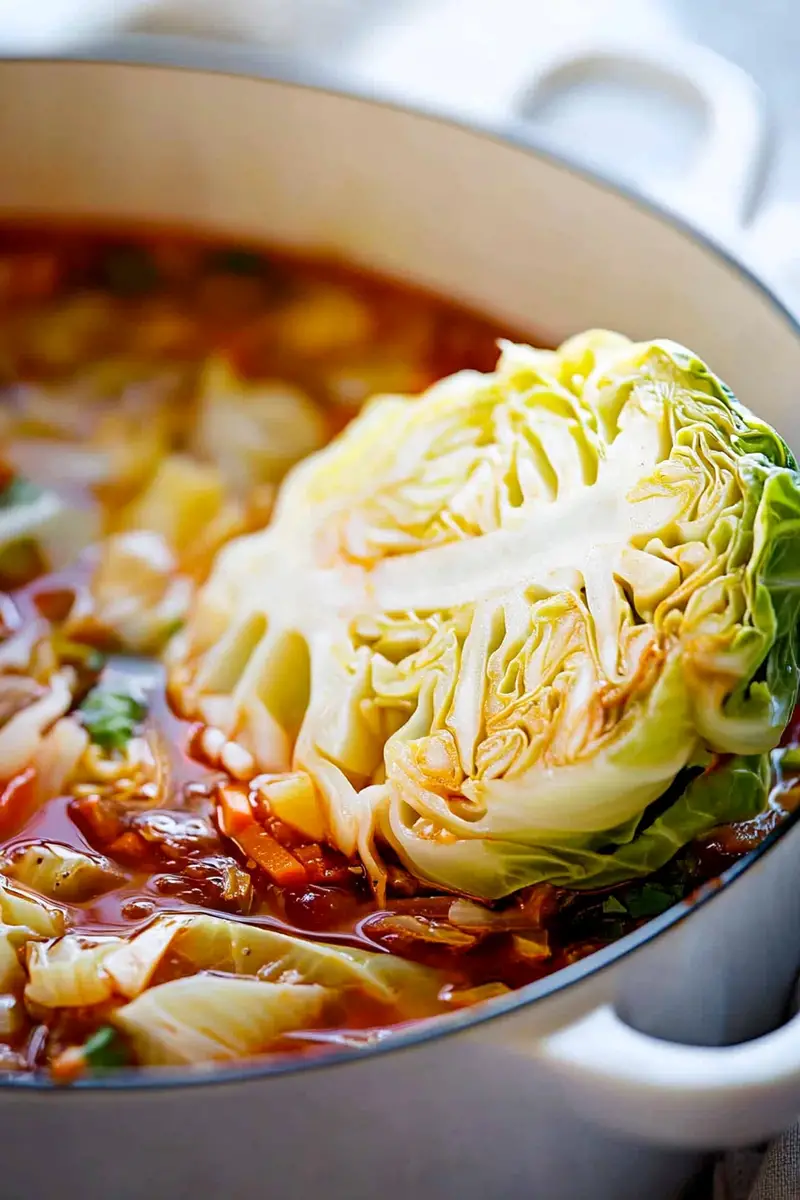
Serving and Storing Tips
Serving Suggestions
When ready to serve ladle individual portions into bowls topping off optionally with fresh herbs such as parsley or cilantro if desired alongside crusty bread slices right next door—this adds delightful crunch factor enhancing overall experience enjoyed across taste buds everywhere! Pairing alongside salad makes enjoyable light lunch option too since these complement each other beautifully balancing out heartiness found within hearty bowl served hot straight from stovetop!
Storing Leftovers
If any leftovers remain after meal has concluded don’t fret—they can be stored conveniently inside airtight containers placed inside refrigerator lasting comfortably up-to five days max without losing quality retained during initial cooking process experienced earlier on day made—just ensure cooling sufficiently beforehand sealing tightly prior putting away! Reheat portions as needed using either stovetop method over low heat setting allowing gradual warming occurring throughout entire contents OR microwave carefully watching closely ensuring even reheating achieved without drying anything out excessively either way chosen!
With these tips at hand enjoy delightful flavorful experience offered through every spoonful enjoyed moving forward always knowing you’ve created something wholesome nourishing good-for-you meals derived directly from nature itself wrapped together perfectly presented within delicious bowlfuls served proudly around family table time again whenever cravings arise needing satisfaction met adequately through comforting favorites shared amongst loved ones gathered close nearby!
Mistakes to avoid
One common mistake when making cabbage soup is neglecting the importance of seasoning. Cabbage has a subtle flavor, and without proper seasoning, your soup may taste bland. Always taste your broth before serving and adjust with salt, pepper, and herbs to enhance the overall flavor. A pinch of cayenne or a dash of hot sauce can also elevate the dish without overpowering it.
Another frequent error is overcooking the cabbage. While cabbage is quite forgiving, cooking it for too long can lead to a mushy texture and loss of nutrients. Add the cabbage toward the end of cooking to retain its crunch and vibrant color. This approach ensures that you get all the health benefits while enjoying a pleasant texture in every spoonful.
Failing to incorporate a variety of vegetables is another pitfall. Cabbage soup can be quite versatile, so consider adding carrots, celery, or bell peppers for added flavor and nutritional value. Each vegetable contributes unique vitamins and minerals that make your soup heartier and more satisfying. Plus, the combination of colors will make your dish visually appealing.
Don’t forget about the importance of broth quality in your cabbage soup. Using water instead of a flavorful broth will result in a less enjoyable dish. Opt for homemade vegetable or chicken stock for depth and richness. If you’re short on time, store-bought options work well but aim for low-sodium varieties to control salt levels.
Lastly, one mistake many cooks make is not letting their soup rest before serving. Allowing it to cool slightly helps the flavors meld together beautifully. If time permits, refrigerating it overnight can intensify the taste even further as the ingredients have more time to blend.
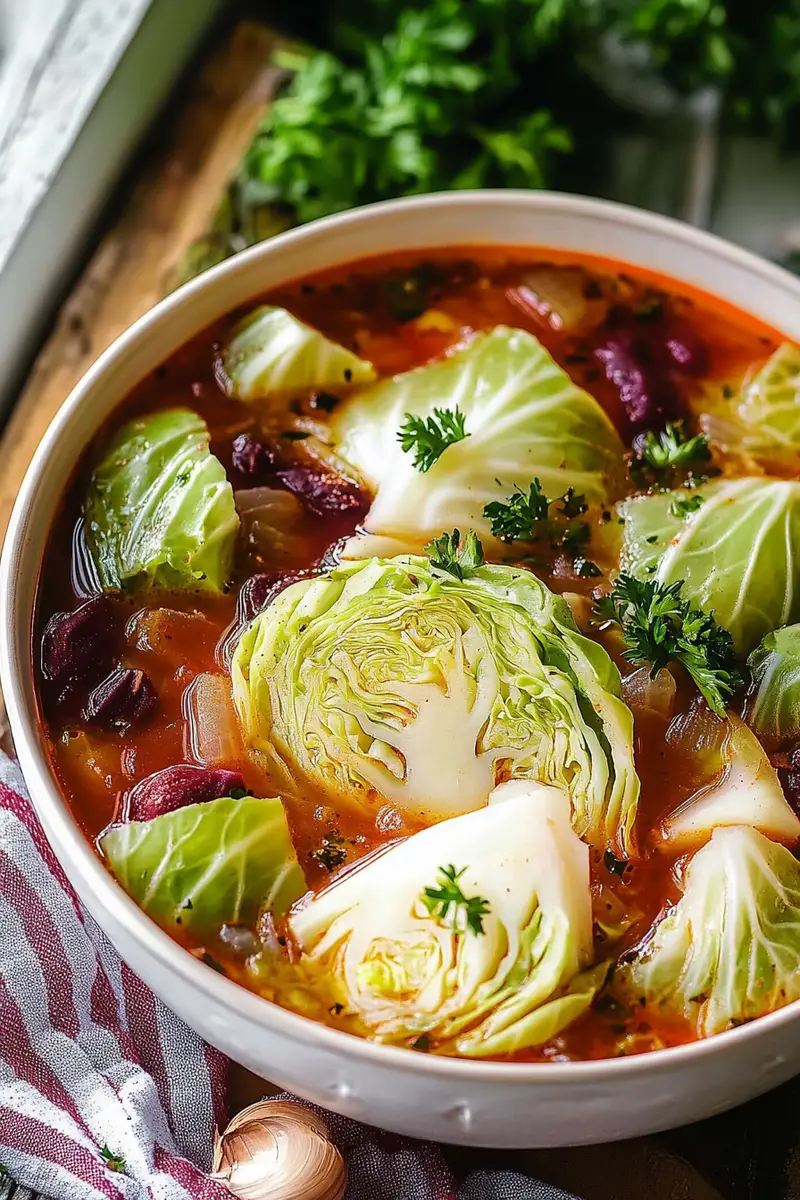
Tips and tricks
To achieve the best results with cabbage soup, start by choosing fresh ingredients. Select firm heads of cabbage with vibrant leaves and no blemishes or discoloration. Fresh produce not only enhances flavor but also provides optimal nutrition in every bowl.
Another helpful tip is to experiment with different spices and herbs. Beyond basic salt and pepper, consider adding thyme, bay leaves, or dill to complement the natural taste of cabbage. These additions can transform your soup from ordinary to extraordinary while providing health benefits associated with various herbs.
For an extra layer of flavor, sauté your vegetables before adding liquid ingredients. Cooking onions and garlic until fragrant allows their natural sweetness to develop while infusing your soup with excellent depth from the beginning. This method creates a solid foundation for savory flavors throughout your dish.
Consider making a large batch of cabbage soup for meal prep purposes. Cabbage soup freezes well; portion it into airtight containers before freezing to enjoy at later dates easily. Having ready-made meals on hand saves time during busy weeks while ensuring you still enjoy nutritious homemade options.
If you’re looking for added protein in your cabbage soup, try incorporating beans or lentils. These ingredients boost fiber content while making your dish more filling without sacrificing flavor or texture. Whether you choose canned or dried legumes, they can seamlessly integrate into your recipe.
Suggestions for Cabbage Soup
For those who want an extra kick in their cabbage soup, try adding some heat with red pepper flakes or chopped jalapeños. Spicy elements can enhance the overall experience by balancing the sweetness of cooked cabbage while providing an exciting contrast in flavors that keeps every bite interesting.
Incorporating different types of meat into your cabbage soup can also elevate its heartiness. Options like diced ham or shredded chicken are great choices that add protein along with rich flavors that complement other ingredients nicely without overwhelming them.
If you’re aiming for a creamier texture in your cabbage soup but still want to keep it healthy, consider mixing in pureed beans or potatoes as thickening agents instead of heavy creams or starches like flour or cornstarch. This choice maintains a light feel while delivering satisfaction through smoothness without unnecessary calories.
Don’t forget about garnishing! Fresh herbs such as parsley or cilantro sprinkled on top just before serving can brighten up flavors visually as well as create an inviting presentation that makes everyone excited about digging into their bowls!
Using acid wisely helps enhance flavors significantly—squeeze fresh lemon juice over each serving just before eating adds brightness while cutting through any heaviness present in richer variations; this small trick brings balance back into focus.
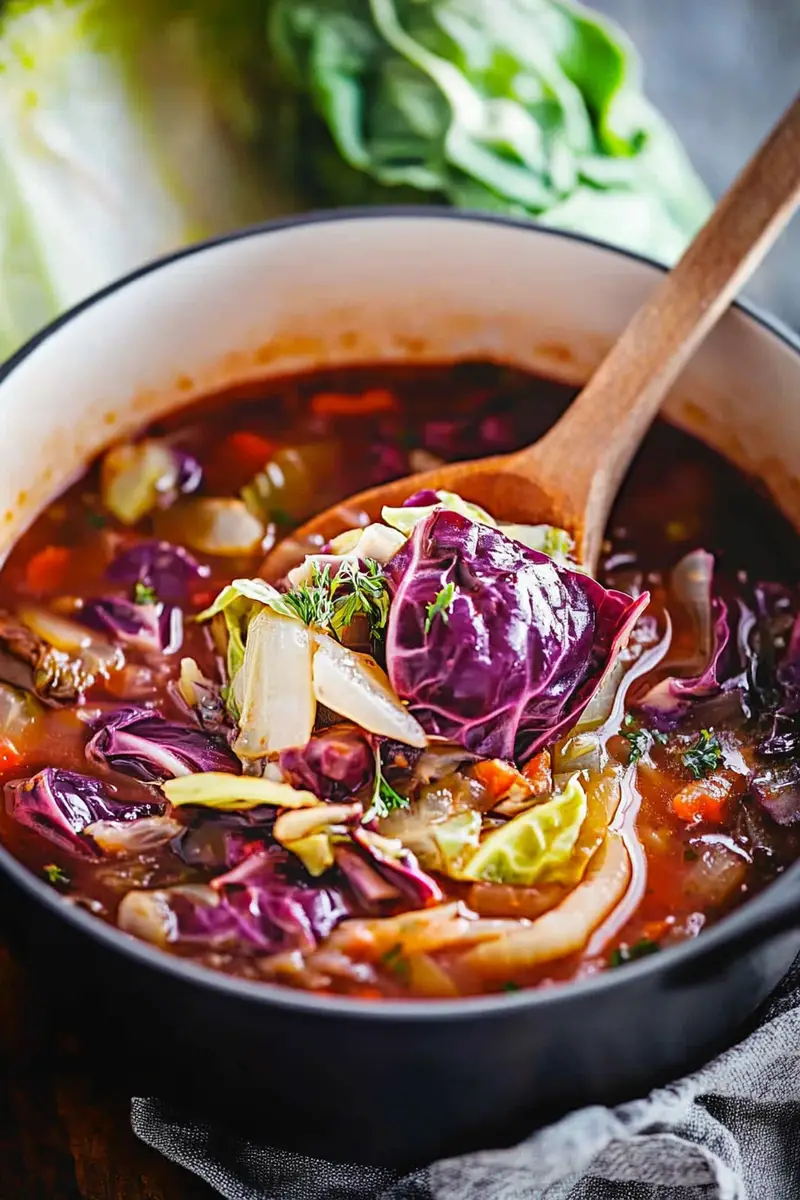
FAQs
What are the health benefits of cabbage soup?
Cabbage soup offers numerous health benefits due to its nutrient-rich ingredients. Cabbage itself is low in calories yet high in vitamins K and C, enhancing immune function and promoting healthy skin. Additionally, it’s packed with dietary fiber which supports digestion by keeping bowel movements regular while contributing to feelings of fullness—great news if you’re managing weight! Furthermore, including various vegetables boosts antioxidant content significantly due to their diverse profiles; this synergy helps combat oxidative stress within cells throughout our bodies effectively over time as well!
Can I use frozen cabbage for my soup?
Yes! Frozen cabbage works well when making soups like this one since freezing preserves most nutrients quite effectively without losing flavor integrity when cooked properly afterward! Just remember not to thaw beforehand—add directly into boiling broth instead so they retain moisture during cooking times efficiently! This method saves prep time too; however ensure you check package instructions regarding cooking duration adjustments since frozen produce may take slightly longer than fresh counterparts would typically require!
How long does cabbage soup last in the fridge?
Properly stored within an airtight container after cooling down promptly post-cooking allows leftover servings from batches made ahead-of-time lasting up four days inside refrigerators safely! To extend shelf life further beyond this timeframe consider freezing portions instead—this way they remain wholesome up six months later unharmed by freezer burn if sealed correctly beforehand!
Can I make vegetarian cabbage soup?
Absolutely! To create a delightful vegetarian version simply replace any meat included originally using plant-based proteins such as lentils beans (canned/dried) alongside vegetable stock instead water base—these alternatives provide heartiness without sacrificing essential nutrients maintaining deliciousness intact throughout preparation process!
What goes well with cabbage soup?
Pairing hearty bread like sourdough baguette alongside simple green salads dressed lightly makes excellent accompaniments complementing rich flavors found within each bowlful enjoyed together effortlessly creating balanced meals perfect every occasion whether casual gatherings holiday feasts alike!
Can I customize my recipe based on preferences?
Certainly! One fantastic aspect about preparing dishes like these lies versatility inherent among them allowing personalization according individual tastes cravings; swap out favorite veggies add spices elevate spice levels adjust thickness depending desired consistency ultimately achieving satisfaction tailored uniquely suited just right you!
Conclusion
Cabbage Soup stands out not only as a warm comfort food but also as a nutritious option packed with vitamins and minerals essential for overall health. By avoiding common mistakes such as under-seasoning or overcooking vegetables, you ensure maximum flavor retention while maintaining nutritional value throughout preparation processes involved here today discussed thoroughly earlier sections above!
Print
Cabbage Soup
- Total Time: 40 minutes
- Yield: 4 servings 1x
Description
This Cabbage Soup is a light, flavorful, and nutritious dish, perfect for warming up on a chilly day. Packed with vegetables and a savory broth, it’s low in calories yet hearty enough to satisfy your hunger.
Ingredients
- 1 small head of cabbage, chopped
- 1 onion, chopped
- 2 carrots, sliced
- 2 celery stalks, chopped
- 3 cloves garlic, minced
- 6 cups vegetable broth
- 1 can (14.5 oz) diced tomatoes
- 1 tsp dried thyme
- 1 bay leaf
- Salt and pepper to taste
- 2 tbsp olive oil
Instructions
- In a large pot, heat olive oil over medium heat. Add onion, carrots, and celery, and sauté until softened, about 5-7 minutes.
- Add garlic, thyme, and bay leaf. Stir and cook for another minute.
- Pour in vegetable broth and diced tomatoes. Bring to a boil, then reduce heat and simmer for 10 minutes.
- Add chopped cabbage, salt, and pepper. Simmer for another 15-20 minutes until the cabbage is tender.
- Discard the bay leaf and serve hot.
Notes
- Feel free to add other vegetables like zucchini or bell peppers for extra flavor and nutrition.
- For added protein, consider adding beans or lean chicken breast.
- Prep Time: 10 minutes
- Cook Time: 30 minutes
Nutrition
- Calories: 120
- Sodium: 550mg
- Fat: 3g
- Carbohydrates: 28g
- Fiber: 6g
- Protein: 3g

